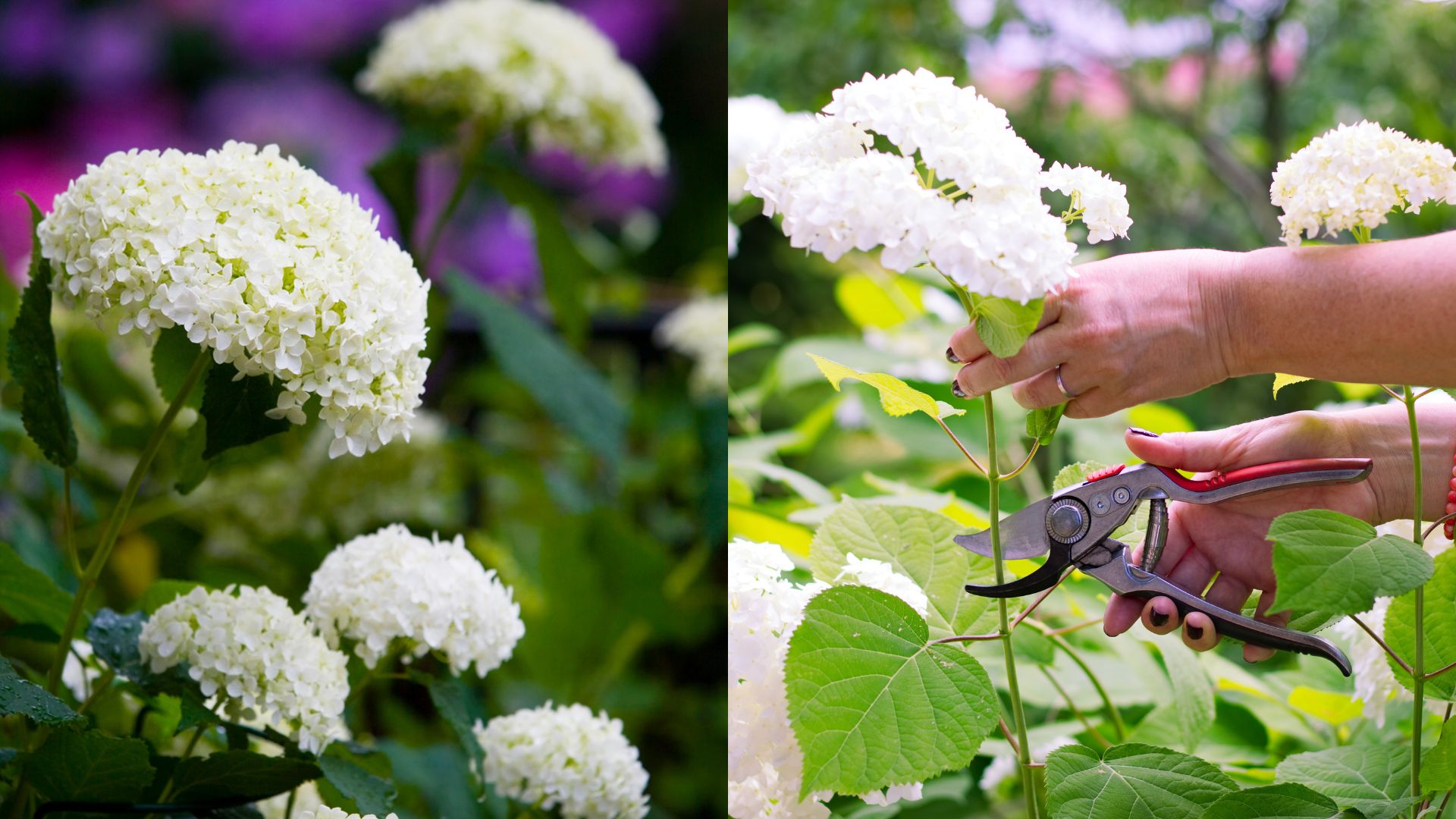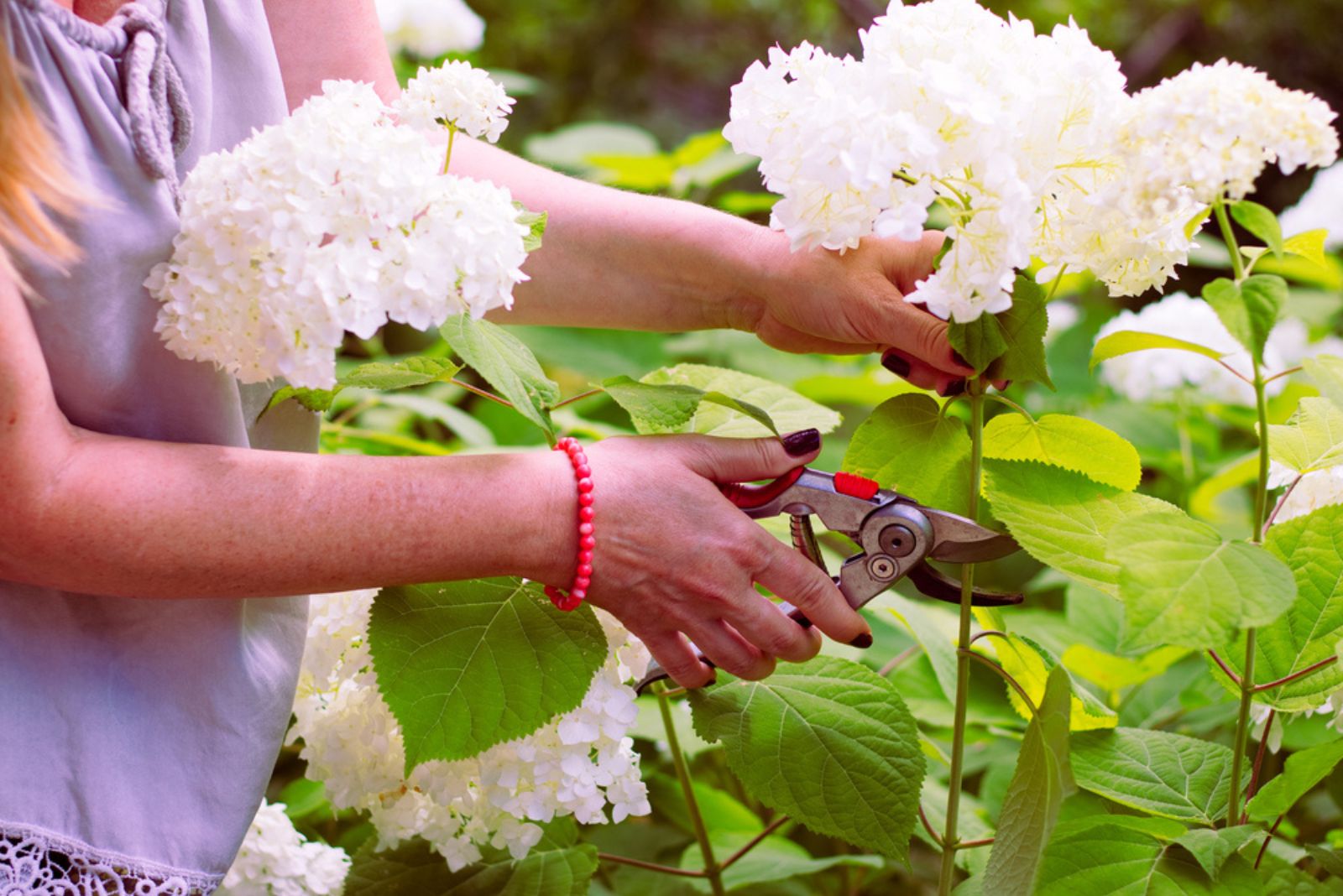There are numerous varieties and cultivars of hydrangea plants and each one has something different to offer. One of my favorite varieties is the captivating Annabelle.
It generates large flower heads filled with an abundance of distinctive hydrangea flowers. If you grow hydrangeas you may know that pruning is one of the ways to encourage growth and blooming in these plants.
In this article, I’ll show you when and how to prune Annabelle hydrangeas for healthy development and an abundance of splendid blossoms.
Let’s get started!
More About Annabelle Hydrangeas
Hydrangea arborescens Annabelle is a breathtaking species from the Hydrangea genus. This is a US native plant and it is renowned for its spectacular large flower heads filled with many white blossoms.
You’ll also find this species under the name wild or smooth hydrangeas.
Annabelle is a deciduous shrub that can grow pretty tall and wide, up to 6 feet. However, you can keep it smaller and more compact by pruning it. This is a low-maintenance hydrangea so beginners shouldn’t face many issues when growing it.
That’s not the only benefit of pruning Annabelle plants; they’ll grow healthier and bloom continuously if you prune them correctly and at the right times.
Let’s find out everything in detail!
When To Prune
When it comes to pruning, timing is essential, and this doesn’t only apply to hydrangeas but to all plants in general. The perfect time for this task also depends on the variety and if you do it too early or too late you may not get the chance to enjoy your Annabelle blossoms.
The essential thing to understand about this variety is that it generates blooms on new growth. This basically means that in order to promote growth and blooming, you need to prune it annually.
The pruning schedule for this variety is similar to that of other types of hydrangeas, such as panicle hydrangeas.
Do not prune your Annabelle until it enters the dormancy stage. The main reason for this is that if you prune while the plant is still growing actively, you’ll encourage it to display new growth.
This may not sound like something wrong but remember that cold weather can easily damage new growth.
You’ll disrupt the natural growing cycle and the plant may not enter dormancy. This isn’t advisable because plants need some rest after the growing season.
Some growers include pruning in their fall hydrangea jobs. This approach may not damage the plant, but it’s not worth the risk and it would be best to delay pruning until late winter or early spring.
Monitor your Annabelle hydrangea and once you see the swelling of its flower buds, take your pruners and start the job.
Another benefit of late winter or early spring pruning is that your Annabelle won’t have any leaves so you’ll get the desired shape easier.
Hydrangeas look great in winter gardens so there’s no need to rush with pruning. Once you complete this task, your Annabelle will start displaying new growth and your garden will look breathtaking.
If you live in cooler climates, delaying pruning until late winter has another benefit; old flower heads will serve as frost protection for the new buds that are forming on the plant.
Do not prune your Annabelle during the summer months because it will encourage the plant to generate new wood growth and that growth won’t display any blossoms during the season.
Instead, you can deadhead your Annabelle hydrangea to encourage more blooms on the existing wood.
How To Prune Your Annabelle Hydrangea
One of the things you have to pay close attention to before you start pruning is getting yourself a sharp pair of pruners and a sterilizing solution.
This is what many growers forget, and the main problem is that it can lead to various issues. If you use blunt cutting tools, there’s a huge risk of breaking the stems and the resulting wounds are susceptible to many diseases.
The risk of dirty tools is just as big; if any of the stems of your plant are diseased you can easily transfer the infection to all other plant parts if you don’t clean your tools.
Once you get clean and sharp pruners or scissors, it’s time for pruning your Annabelle. Luckily, these plants don’t require heavy pruning and won’t be too stressed after pruning.
Your first goal should be to cut off all the diseased, damaged, or discolored parts on your Annabelle hydrangea.
After all these parts are removed, you can continue to prune for reshaping. The first step is to thin your Annabelle by cutting off older and taller stems and weak growth.
If you ever get advice to cut this plant to the ground, please do not listen to it. Heavy pruning in Annabelle hydrangeas may lead to various issues after the plant starts growing again.
First, your plant won’t generate new stems that are robust enough to support the flower heads. And second, as soon as the raindrop hits your area, the stems will quickly flop.
If you think your Annabelle needs heavier pruning, you should consider an alternative. For instance, cutting the stems down to approximately 2-3 feet will leave enough growth to support the development of flower heads.
Those who have a hedge trimmer can quickly finish this task; remove the stems down to 2-3 feet and then cut every third Anabelle stem down to the ground.
Be sure not to damage any newly-formed buds found in the crown of your Annabelle plant. Remember that the new blossoms will develop from these buds the following season.
Growing hydrangeas, especially Annabelle varieties, is a super fun and rewarding task. You should include pruning on your hydrangea to-do list and now that you know how to do it, there’s no reason why your Annabelle won’t thrive for many years to come!


